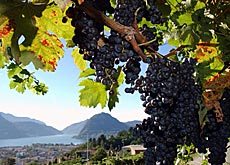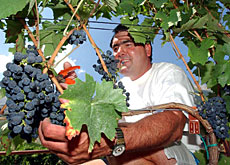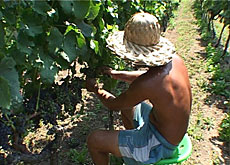Ticino toasts its Merlot wines

Switzerland's southern canton of Ticino is raising a glass to a century of local wine production using merlot grapes.
The first attempts to cultivate this variety in the region were rather haphazard and it took a further 50 years before merlot became the Ticinese wine par excellence.
Eros Walter, president of the Merlot06 centenary celebrations and vice-president of Federviti, the federation of Ticinese winemakers, said that it was only after the end of the Second World War that the approach to making wine became more scientific.
“Vines grew nearly everywhere, in the wild, the middle of fields, between farms. Over the years, vineyards underwent a transformation due to mechanisation and the progresses in oenology,” he said.
It was in the 1980s that the locally produced merlot finally took flight and became known outside Swiss borders.
The first official record of merlot cultivation was mentioned in agricultural annals from 1906.
This was the year when the first wine produced from these grapes was of a high quality or cru. During the same year, the region’s vineyards were also officially analysed for the first time.
Going back
Before the 20th century, winemaking in Ticino was dominated by hybrid varieties, including one called Isabella.
According to Mario Fregoni, viticulture professor at the Catholic University del Sacro Cuore at Piacenza, in neighbouring Italy, it was a grape that was remembered for all the wrong reasons.
“The memory of Isabella is still strong in some old men because of the illnesses it caused in drinkers,” Fregoni said.
Local winemakers tried to cultivate a number of different varieties before finally deciding on merlot, which was imported from France.
“This choice transformed Ticinese vineyards into a veritable enclave of merlot,” Fregoni said.
Fregoni – who will preside over the international symposium on merlot, which takes place in September in the southern city of Lugano – says that this variety has adapted well to the local terrain.
However, it was thanks to the hard graft put in by men that this vine flourished.
“Through sacrifice, they built up a heroic viticulture on sloping ground, which fits in well with the marvellous local landscape,” Fregoni said.
Vast areas
Today merlot grapes account for 83 per cent of the total area cultivated by Ticino’s winemakers.
More than 1,000 hectares of vineyards are distributed equally between the north and south of the canton.
“We’re talking about the largest surface area in the world which is cultivated by one single grape variety,” says Walter of the winemakers’ federation.
Half of the canton’s 200 winemakers are engaged in growing merlot; five million bottles are sold every year.
Some 40 per cent stays in the canton in which it is produced, whereas 55 per cent is exported to other parts of the country.
Only five per cent makes its way to the rest of Europe and the United States.
“We have found it difficult to market our merlot in France – the competition there is too tough,” said Walter.
As for the future, the Merlot06 celebrations should help to make the wine produced in Ticino better known.
And change is assured thanks to a group of 30 young winemakers who already have established reputations.
“To mark the centenary, the Ticino tourist office has launched an international campaign to promote its merlot wines,” Walter said.
He added that there were plans to open a multimedia centre on wine and vines at the Sasso Corbaro castle in Bellinzona.
“But I fear that this all won’t take place tomorrow,” Walter said.
swissinfo, Gemma d’Urso, in Lugano and Bellinzona
The 100th anniversary of winemaking from merlot grapes in Ticino will be celebrated throughout the canton in 2006.
Conferences, exhibitions, plays, concerts and an international symposium are also on the agenda.
Celebrations – which began in January – will continue until November, ending in Chiasso.
The Merlot grape is considered a close cousin of Cabernet Sauvignon.
It is lower in tannins and makes wines that mature faster and are softer in texture.
Merlot can grow in regions that are cooler than those required for Cabernet Sauvignon.
But it is more susceptible to fungus and mould diseases.

In compliance with the JTI standards
More: SWI swissinfo.ch certified by the Journalism Trust Initiative


You can find an overview of ongoing debates with our journalists here. Please join us!
If you want to start a conversation about a topic raised in this article or want to report factual errors, email us at english@swissinfo.ch.